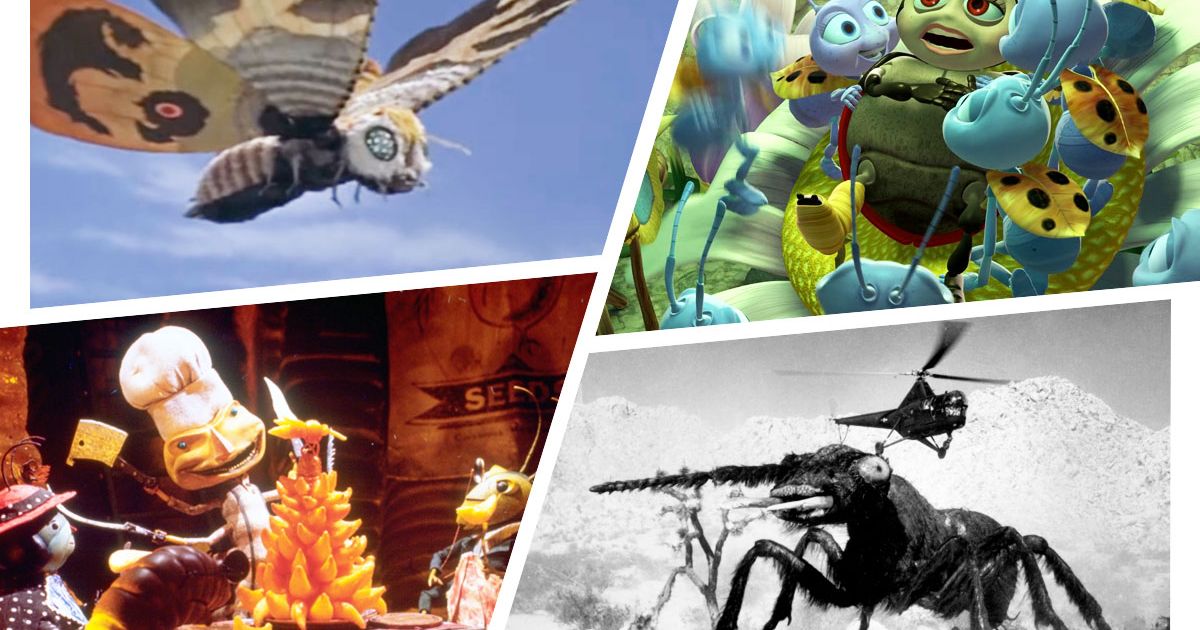
The 12 Best Bug Movies
Vulture, being an animal itself, will find any occasion to honor all wildlife. And before you start, yes, bugs are animals too. They flutter around our lamps at night. They creep across our bedroom floors. They chew tunnels under our feet and make nests in our kitchen pantries. Whether we like it or not, bugs are all around us, including on our screens, growing huge enough to knock down skyscrapers, sending colonies of their workers to invade our small towns, and setting off on micro-adventures to entertain our children.
There are tons of weird, gross, and scary bug movies out there, but what does it take to make a great one? To finally answer this question, we have created the Bug Movie Canon, a list of 12 of the best bug movies ever made, across a wide range of genres (but, let’s face it, mostly horror), that attempts to encapsulate even a fraction of the infinite variations of the arthropod world.
Be terrorized by a giant Japanese moth! Fight back against a race of intelligent ants! Travel across the sea in a giant stone fruit! Turn on your porch lights, open your door, and welcome them inside. They’ll get in anyway.
Them! (1954)
–>
The dawn of the atomic age raised a lot of terrifying questions, and Them! explores one of them: What if the U.S. government’s very first atomic-bomb test irradiated a bunch of ants and made them grow huge and hunger for the flesh of man? The film stars James Whitmore as a local police sergeant who, along with two myrmecologists (that’s biologists who study ants), discovers and eventually eradicates a colony of enormous ants wreaking havoc in the New Mexico desert. It was supposed to be shot in 3-D (can you imagine???); the equipment malfunctioned on the first day of testing, but the giant ants are still creepy in two dimensions. Them! was the first of the decade’s horror-thrillers starring giant bugs (later came scorpions, grasshoppers, mantids, spiders, and wasps — you could make this entire list out of giant bug movies from the ’50s and ’60s), but it is also the best, and it sits among the great “nuclear monster” films of the atomic age, feeding off the anxious notion that no one knows what horrors lie in future scientific discoveries.
Mothra (1961)
–>
I mean, obviously. The most beloved of the Japanese kaiju other than Godzilla himself, beautiful Mothra swoops over monster brawls on wings a quarter of a mile wide, breaking up fights and saving civilians from the wrath of superpowered titans. First introduced in 1961’s Mothra, the insect goddess resides on Infant Island, worshiped by peaceful natives and communicating through two tiny fairy proxies who sing songs to wake her or put her to sleep. When her companions are abducted and put on display, Mothra terrorizes the countryside to rescue them. A marvel of special effects and color composition, the film is a perfect example of how great monster movies can be scary as well as thoughtful, casting a giant bug as both adversary and protagonist.
Phase IV (1974)
–>
You may recognize Saul Bass’s name from his iconic opening title sequences, most notably for Alfred Hitchcock and Martin Scorsese, or for his equally iconic movie posters for the likes of The Man With the Golden Arm and Anatomy of a Murder. Bass was an expert at condensing the essence of a film down to a minute or two, or even just an image, and he only directed one feature: the underrated bug-horror banger Phase IV. The film, inspired by an H.G. Wells short story, takes place in the middle of the Arizona desert, where a couple of scientists have been sent to eradicate a multispecies colony of ants that have gained sentience through extraterrestrial cosmic radiation and have built a series of geometrically perfect towers. Following the “phases” of the ants’ rapid evolution, the film bounces between tense scenes in the scientists’ makeshift laboratory and extreme close-ups of ants in motion, fighting, communicating, being hunted by a praying mantis, and foiling every attempt to exterminate them. The result is a visual marvel with an abstract composition that borders on the experimental, as well as a terrifying account of ants’ indestructible nature: “So defenseless in the inpidual,” Nigel Davenport’s Dr. Hubbs says, “so powerful in the mass.”
Phenomena (1985)
–>
While not the most beloved of Italian giallo master Dario Argento’s films — in part because it suffered from a truncated recut release in the United States — Phenomena is still a worthy horror film in its own right. Argento got the idea from a radio broadcast about a murder that was solved using the evidence of insects present on the corpse, but imbued the tale with his own love of the supernatural and the stranger. The film stars Jennifer Connelly as a student at a remote Swiss boarding school who uses her psychic connection with insects to catch a serial killer targeting young girls on the grounds. While the acting runs the gamut from stilted to overly comically hysterical, it’s worth a watch mainly for the bug stuff: The movie’s use of real insects ran the budget up to 6 million lire after Argento used exotic imports and locally raised flies and wasps for Connelly’s paranormal visions — even, in one case, tying a nylon string around a live fly for Connelly to follow around.
The Fly (1986)
–>
Not many would take on the terror of Kurt Neumann’s 1958 classic The Fly, unless they were a Canadian horror master hell-bent on taking the merely “nasty” to entirely new levels of disgust and delight. David Cronenberg’s The Fly is a body-horror sensation, gooey and gross, casting Jeff Goldblum as Seth Brundle, a scientist studying instant-teleportation technology who accidentally fuses his own body with that of a housefly. As the fly biology takes over his own, Brundle starts growing thick hairs from his back, vomiting digestive enzymes into his food, and climbing up walls and ceilings as his human empathy quickly slips away. His final transformation into the superhuman “Brundlefly” is one of the scariest, most delightfully disgusting scenes in cinema history.
(If you find yourself in a fly-movie mood, check out S.S. Rajamouli’s Eega, about a man reincarnated as a fly desperate to avenge his own murder and stop his former lover from marrying a criminal.)
Arachnophobia (1990)
–>
Fear of spiders is one of the most fundamental phobias of the human brain. We seem to be born with it, encouraged by spider-themed horror movies and Halloween decorations. Perhaps the most effective at capturing this primal fear is Frank Marshall’s Arachnophobia, expertly straddling the line between horror and comedy as it spins a yarn about a small California town infested with venomous spiders. Jeff Daniels is game as the spider-fearing town doctor, as is John Goodman, who makes a surprise appearance as a gruff bug-obsessed exterminator. The spiders in the movie are a fictional species with a hive mind controlled by a spider queen, combining our innate fear of spiders with our aversion to zombie drones deployed by an intelligent overmind. It’s also just freaky, with eight-legged creatures scuttling around everywhere, and will have you thinking twice about reaching your hand under any lampshades anytime soon.
James and the Giant Peach (1996)
–>
Because everyone’s so afraid of bugs, this list — and the history of bug cinema — is heavy on horror, but there are exceptions. James and the Giant Peach, Henry Selick’s adaptation of the Roald Dahl children’s book about a young boy who crosses the Atlantic Ocean inside an enormous peach populated by a group of talking insects, is one such example. Jerky, angular stop-motion is the ideal medium to bring this story to life, perfectly capturing the distorted shapes and otherworldly body motions of its bug characters and imbuing each one with its own irresistible personality. Dandy Mr. Grasshopper is charming, rude Mr. Centipede is hilarious, and hypnotic Miss Spider is dangerously alluring. Led by a fantastic voice cast — Susan Sarandon! Richard Dreyfuss! Miriam Margolyes! — the film is an instant classic for those of us who spent playtime digging in the dirt in search of everything small.
Microcosmos (1996)
–>
Nowadays, you can find stunning footage and comprehensive documentaries about insects just by googling the right keywords, but a French documentary a little more than an hour long from 1996 remains the best nonfiction film about the tiny worlds of insects. Directed by Claude Nuridsany and Marie Pérennou, Microcosmos screened out of competition at that year’s Cannes Film Festival, delighting its audiences with macro footage of tiny, fascinating insects. The film features very little narration (the English version was dubbed over by Kristin Scott Thomas), allowing the bugs to speak for themselves, climbing up the trunks of trees, emerging from cocoons, fighting, mating, and surviving in all of their strange little ways.
Mimic (1997)
–>
Guillermo del Toro’s least-loved horror movie is better than you think, especially when it comes to pure practical-effects movie magic. No one really does it like him, and in the hands of a lesser director, Mimic, a pulpy thriller about a mutant species of cockroach haunting the sewers of New York City, wouldn’t have nearly the same creepy bite. To eradicate cockroaches spreading the deadly “Strickler’s disease” throughout the city, an entomologist genetically engineers a “Judas breed” of mantis-termite hybrids containing an enzyme that, when eaten by a roach, accelerates the their metabolism and causes them to starve to death, effectively clearing them out within a generation. What she didn’t expect was that the roach infestation would be replaced by the Judas breed, whose hyperactive metabolism causes them to undergo rapid evolution into a new species of insectoid superpredators that hunt humans by expertly mimicking their shape — until you get too close.
A Bug’s Life (1998)
–>
Of course, we’d never forget about A Bug’s Life, Pixar’s second feature-length film that confirmed computer animation’s place in cinema’s future. More than 20 years on, the style has aged, but barely, thanks to Pixar’s astute choice to focus on things with simple bodies and jointed limbs (bugs, toys, etc.) while they perfected their craft. When Flik, a young worker ant living on Ant Island, destroys the store of food the ants have been gathering for a swarm of evil grasshoppers, he’s forced to gather a misfit crew of bugs to save the anthill from the grasshoppers’ wrath. A Bug’s Life is hilarious, it’s exciting, and it’s endlessly creative, using the minuscule setting to its fullest advantage, building structures out of leaves and sticks and setting action scenes during rainstorms with bomb-size droplets.
Enemy (2013)
–>
Before Denis Villeneuve was taking on Hollywood sci-fi blockbusters like Blade Runner and Dune, he was making waves in his home country of Canada for dramas that explored the cerebral and the strange. One of these is Enemy, starring Jake Gyllenhaal as a Toronto history professor who, while watching a movie one night, sees an actor in a bit role who looks exactly like him. He quickly becomes obsessed with his double, attempts to become friends with him, and then, after meeting his beautiful wife and getting a taste of his flashy, moderately successful career, tries to steal his life. It’s never clear whether the two men are twins or actually the same person: After they meet, they start sharing dreams of women with the heads of spiders, and of giant spiders walking amongst the city skyscrapers. It’s a hypnotically perplexing film that invites any number of opposing interpretations, culminating in a final scene that’s as funny as it is disturbing. We won’t spoil anything, but there is a spider in it.
Saint Maud (2020)
–>
In Rose Glass’s feature debut Saint Maud, Welsh actress Morfydd Clark stars as Maud, a palliative-care nurse working for a cancer-stricken former dancer named Amanda living in a blustery seaside town. Maud found religion after experiencing an unknown past trauma, and she is now a devout Roman Catholic determined to save the soul of the hedonistic Amanda, who only wants to take pleasure in her last days. As Maud’s mind begins to unravel, she is encouraged in her quest by what she interprets as heavenly visions of the voice of God in the form of a talking cockroach that crawls all over the floors and ceilings of her tiny apartment and tells her repeatedly to prove her faith. Saint Maud is a marvelously mean psychological horror with a faith-based twist, proving that the things that frighten us the most don’t always have to be supersize monsters, and the voice of the pine can be found in even the lowest of creatures.
Related
- The 15 Best Snake Moments in Movie History
- The 12 Best Shark Movies Since Jaws
- The Best Cat Movie Performances, Ranked



























































